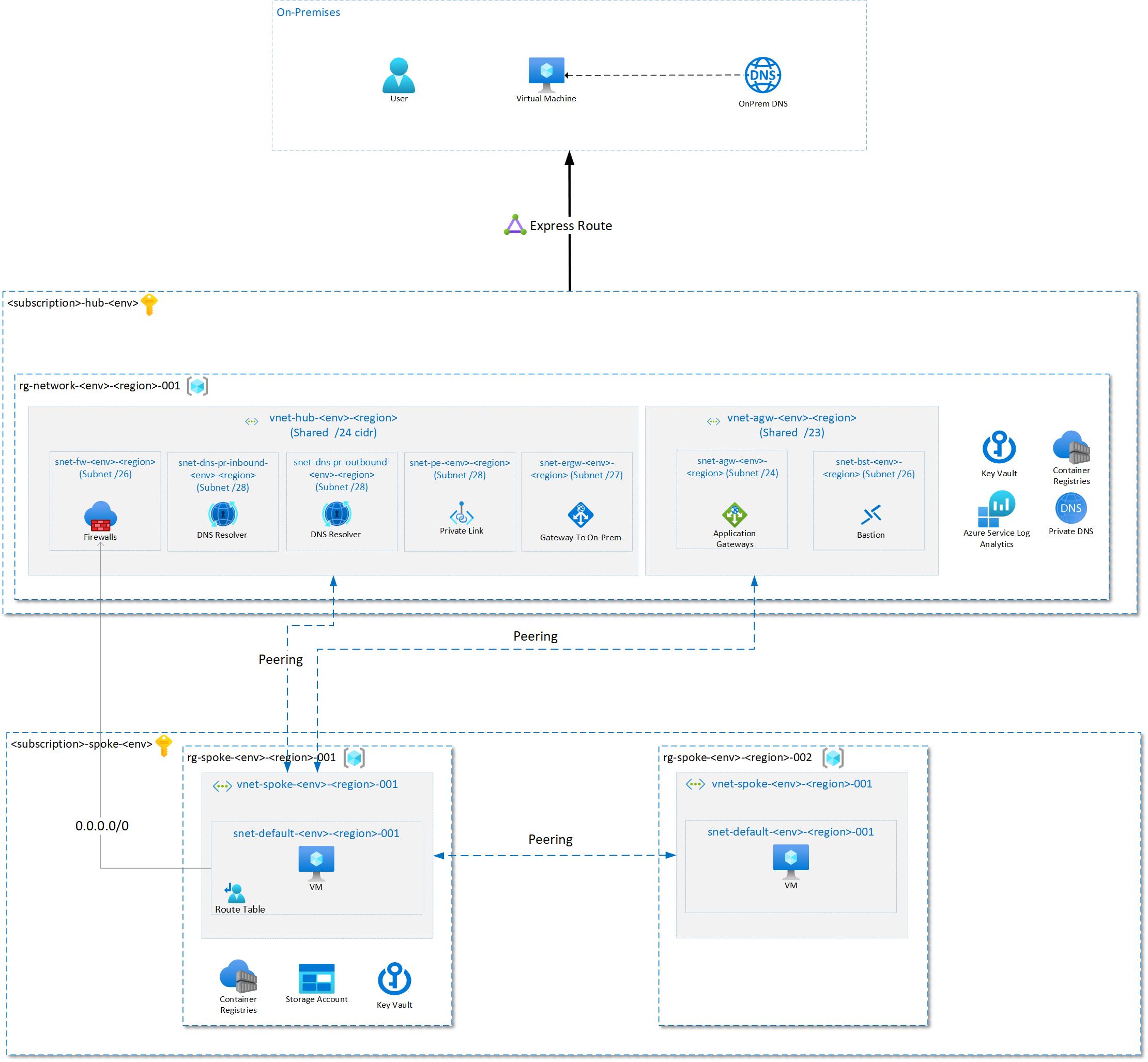The following diagram shows a simplified version of a Hub & Spoke architecture on Azure.
-
Install PowerShell Module. Run the following command within your PowerShell:
Install-Module -Name Az
-
Set some environment variabels before running the scripts:
$AZURE_SUBSCRIPTION_ID_HUB = 'HUB_SUBSCRIPTION_ID' $AZURE_SUBSCRIPTION_ID_SPOKE = 'SPOKE_SUBSCRIPTION_ID' $DNS_SERVER_ON_PREM_IP='INSERT_IP_HERE' $HOSTNAMES_ON_PREM=@('HOSTNAME_ON_PREM_1.','HOSTNAME_ON_PREM_2.') # don't forget about the trailing dots at the end!
-
Setup basic Hub infrastructure:
- There are 5 different packages which can be executed independently:
- Setup the central Hub:
./hub/main.ps1 - Setup the central Application GW Hub:
./hub_agw/main.ps1 - Setup the Spoke:
./spoke_spokeName1/main.ps1 - Setup another Spoke:
./spoke_spokeName2/main.ps1 - Setup VNET peering:
./vnet_peering/main.ps1
- Setup the central Hub:
- Hint: All variabels will be managed centrally in the
_variables.ps1file within the packages.
- There are 5 different packages which can be executed independently:
-
Setup Connection to On-Prem:
- Run scripts consisting of ExpressRoute configuration
- Make sure that you deploy the ExpressRoute into the subnet within the previously created infrastructure
- Hint:
- ENV: Describes the development environment. (dev, staging, prod, etc.)
- LOCATION: Describes the Region in Azure. (westeurope, eastus, etc.)
- Name:
vnet-hub-{ENV}-{LOCATION}-001 - Example network:
20.13.252.0/24
The following table shows the network segmentation consisting of all existing subnets.
| Subnet address | Netmask | Range of addresses | Useable IPs | Hosts | Subnet name |
|---|---|---|---|---|---|
| 20.13.252.0/26 | 255.255.255.192 | 20.13.252.0 - 20.13.252.63 | 20.13.252.1 - 20.13.252.62 | 62 | - |
| 20.13.252.64/27 | 255.255.255.224 | 20.13.252.64 - 20.13.252.95 | 20.13.252.65 - 20.13.252.94 | 30 | GatewaySubnet |
| 20.13.252.96/27 | 255.255.255.224 | 20.13.252.96 - 20.13.252.127 | 20.13.252.97 - 20.13.252.126 | 30 | - |
| 20.13.252.128/26 | 255.255.255.192 | 20.13.252.128 - 20.13.252.191 | 20.13.252.129 - 20.13.252.190 | 62 | AzureFirewallSubnet |
| 20.13.252.192/28 | 255.255.255.240 | 20.13.252.192 - 20.13.252.207 | 20.13.252.193 - 20.13.252.206 | 14 | snet-dns-pr-inbound-{ENV}-{LOCATION}-001 |
| 20.13.252.208/28 | 255.255.255.240 | 20.13.252.208 - 20.13.252.223 | 20.13.252.209 - 20.13.252.222 | 14 | snet-dns-pr-outbound-{ENV}-{LOCATION}-001 |
| 20.13.252.224/28 | 255.255.255.240 | 20.13.252.224 - 20.13.252.239 | 20.13.252.225 - 20.13.252.238 | 14 | snet-private-link-{ENV}-{LOCATION}-001 |
| 20.13.252.240/28 | 255.255.255.240 | 20.13.252.240 - 20.13.252.255 | 20.13.252.241 - 20.13.252.254 | 14 | - |
- Name:
vnet-agw-{ENV}-{LOCATION}-001 - Example network:
172.16.224.0/23
The following table shows the network segmentation consisting of all existing subnets.
| Subnet address | Netmask | Range of addresses | Useable IPs | Hosts | Subnet name |
|---|---|---|---|---|---|
| 172.16.224.0/24 | 255.255.255.0 | 172.16.224.0 - 172.16.224.255 | 172.16.224.1 - 172.16.224.254 | 254 | snet-agw-{ENV}-{LOCATION}-001 |
| 172.16.225.0/25 | 255.255.255.128 | 172.16.225.0 - 172.16.225.127 | 172.16.225.1 - 172.16.225.126 | 126 | - |
| 172.16.225.128/26 | 255.255.255.192 | 172.16.225.128 - 172.16.225.191 | 172.16.225.129 - 172.16.225.190 | 62 | AzureBastionSubnet |
| 172.16.225.192/26 | 255.255.255.192 | 172.16.225.192 - 172.16.225.255 | 172.16.225.193 - 172.16.225.254 | 62 | - |
